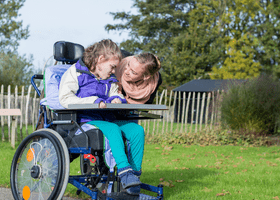Making Outdoor Learning happen for those with disabilities and special needs
One of the many beauties of the outdoors is that absolutely anyone can enjoy it and I am the person to save you time by giving you some top tips you can put in place today!
As an Outdoor Learning Consultant several times a year I train and support teachers who are teaching children with disabilities, severe autism, nonverbal and various other specific needs. I also spend many hours making and writing resources for my SEND teachers and children. So here are three ideas for you that go down really well with our Muddy Puddle Teacher Schools.
- Muddy Experience Cards
Each half term spend some time sitting down with your staff and create a Muddy Experience the children can access each day. It does not have to be a long experience just a short snappy 10-minutes out of your day every day. Obviously, you know your children best and for each of you, you may need to tailor these cards around your children’s needs. Here are a few ideas I have tried:
- Go on a bug hunt, feel the wind in your hair, rain on your skin or grass on your toes. The outdoor presents many sensory experiences for us that calm and relax.
- You could also go cloud watching, count the birds or spend 5 minutes quiet listening to the rustling of the trees or the chirping from the birds.
- It does not have to be anything complex but make sure you go out all weathers because different seasons and weather types present different sensory experiences!
- Muddy Welly Walks
You may already go for walks with your lovely children but why not try doing some of them the Muddy Way! If you do not go for regular walks, start by pencilling one in every half term or every fortnight, building up to one every week when the weathers improve.
Add a little fun to your walks by giving them an imaginative theme. For instance, read the book ‘Were going on a Bear Hunt’ by Micheal Rosen and then go on a bear hunt. Read the story as you go and encourage the children to repeat the words back or if they’re non-verbal have actions to help with interaction. Children could also tap along bashing sticks together. Another great book for rainy days is ‘Watch out for Muddy Puddles’ by Ben Faulkes. Every time you get to a puddle children could jump in or drive through the puddle in their wheelchair hearing the splashing of the water and imagine you can see the characters the child does in the story. It does not always have to be book related. I have often gone on a dinosaur hunt and we have wondered and been curious if we have found broken sticks a dinosaur may have stepped through and at the end I had a giant blown up balloon of a dinosaur at the end. The children loved it. The children do like to find something at the end, if you do have the time it is well worth sending a staff member out to plant something on route! For instance, at Easter time I would lay a trail of broken carrots with Peter Rabbit waiting for us at the end. Let those imaginations wander and take the children’s interests too and go for a Harry Potter or Spiderman walk!
- Muddy Seasons
There is a lot of research behind the fact that nature is healing. Nature is our habitat, we are nature! So get out there and connect with it and give children time to feel it. To learn more about the profound impact of nature on well-being, this Times article is very interesting. https://time.com/4405827/the-healing-power-of-nature/
This is a lovely feature to spend a full day concentrating on. Call it a ‘Muddy Spring Day’ or ‘Muddy Winter Day’ and have the whole day focused on that season using as many real items as possible focused around that season. So for instance, if it’s Autumn have lots of acorns, pine cones and conkers at the ready! Start the day by going for a walk in a green space, take a little brown paper bag, find items and pop them in your bag. You could also send a brown paper bag home before the day for children to bring items in from home. Once back in the classroom, look through your items and for those children who may have disability issues to touch or hold the items, help them feel the textures if they are happy for you to do so. Talk about the colours you see and sort them by size, textures and length. You could then make something with them a natural art picture for instance. Spend the rest of the day surrounding yourselves with that season. By playing music that is all about that season, make art and crafts such as painting sunflowers in summer and making cloud mobiles with droplets of rain coming down for Autumn. The children could also dress in a colour that represents that season, such as a yellow T.Shirt for Spring. In your continuous provision, you could have conkers on a tuff spot with ramps for them to roll down in Autumn or sunflower seeds in a tray to play with.
Sign up and access all of our SEND Outdoor Learning Training & Resources


